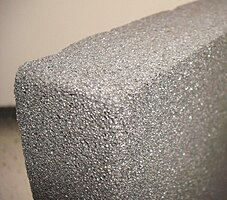Foam glass
| Foam glass | |
|---|---|

|
|
| origin | |
| raw materials | Waste glass and additives |
| Primary energy consumption (production) | 750-1,600 kWh / m³ |
| Material properties | |
| Thermal conductivity λ | 0.036-0.060 W / (m · K) |
| Specific heat capacity c | 840-1,100 J / (kg K) |
| Bulk density ρ | 100-165 kg / m³ |
| Vapor diffusion resistance μ | ∞ (practically vapor-tight) |
| Building material class | A1 |
| commitment | |
| Areas of application | see: Use |
Foam glass is a heat insulation material made of foamed glass for the construction and civil engineering and industrial installations. Dimensionally accurate plates, pipe sections, segments and other parts are made from it. Foam glass is also used in extreme conditions - e.g. B. in the insulation of buildings against the ground in pressing water. For installation in the floor, in addition to sheet material, foam glass gravel can also be used. Expanded glass is produced and used in a similar way, and through targeted shaping it enables a broader range of applications.
Manufacturing
The production of foam glass is mainly a thermal process, in which heat is supplied in energy-saving low-temperature ovens for glass melting and foaming.
The main raw material for the production of foam glass today is more than 66% flat glass recyclate , which is obtained from car and window panes. This eliminates a large part of the energy-intensive preliminary stage of glass production from quartz sand . Feldspar , dolomite , iron oxides , manganese dioxide and sodium carbonate are used as other raw materials .
After the glass has melted , the cooled glass is ground in ball mills , a small amount of carbon is added and placed in stainless steel molds . These then pass through a foaming oven; This creates a hermetically sealed cell structure in the product with thin cell glass walls, which is retained by the controlled cooling process in the stretching oven . After cooling, a permanent negative pressure of approx. 0.5 bar is created inside the cell, which also reduces the thermal conductivity.
In the meantime, there are also more energy-efficient processes in which the mixture of glass powder and foaming additive is foamed into an endless belt in a tunnel furnace without molding. Due to strong cooling, the tape breaks into foam glass gravel at the end of the process.
properties
Foam glass is heat-insulating, waterproof, pressure-resistant (but not suitable for high point loads), vapor-tight , dimensionally stable, non-flammable, acid-resistant, pest-proof and easy to work with. Intact foam glass absorbs practically no water .
Due to the open and hard pore surface, foam glass itself is not frost-proof and resistant to frost changes, since water that penetrates the foam glass gradually bursts through the increase in volume when it freezes. This leads to (initially) invisible microcracks which, due to the capillary action , continue to spread, penetrate the material and allow water to be absorbed. This also significantly reduces the insulation effect. The surface is also mechanically sensitive, which is why it must be protected by paints made of asphalt or other coatings. In the form of foam glass gravel , which is produced by baking at temperatures of up to 1000 ° C, it is largely resistant to environmental wine flows and, due to almost no water absorption, also frost-proof.
In principle, recycling is possible by melting the foam glass again. The product can be dumped as building rubble; Material glued with bitumen can also be used in granulated form for road construction.
The foam glass cells contain carbon dioxide and hydrogen sulfide (from the sulfur content of carbon). If foam glass is processed, small amounts of hydrogen sulfide can escape.
use
Areas of application in building construction are:
- Flat roofs / pitched roofs
- Green roofs
- Parking decks / terraces
- Perimeter insulation of the external earth wall / floor / load-bearing foundation slabs
- Walls / facades
- Interior insulation
- Insulation of thermal bridges
Areas of application for industrial systems are:
- Pipelines
- Steel tanks and vessels
- Concrete containers
- Fresh air intake ducts
- Concrete / steel air intake ducts
- Industrial chimneys
- Cold stores
Norms
- EN 13167 Thermal insulation products for buildings - Factory made foam glass (CG) products - Specification .
Individual evidence
- ↑ http://www.waermedaemmstoffe.com/htm/schaumglas.htm
- ↑ a b Entry on foam glass. In: Römpp Online . Georg Thieme Verlag, accessed on August 5, 2013.
- ↑ Lajos Joos: Energy saving in buildings: state of the art . Vulkan-Verlag GmbH, 2004, ISBN 3-8027-2376-7 , p. 74 ( limited preview in Google Book search).
- ^ Siegmund Becker: Expert opinion on the municipal indoor swimming pool Kassel - Stadtbad Mitte , January 12, 2006, p. 9
literature
- F. Dehn, G. König, G. Marzahn: Construction materials in building . Ernst & Sohn, 2003, ISBN 978-3-433-01652-7 , p. 576 ( limited preview in Google book search)